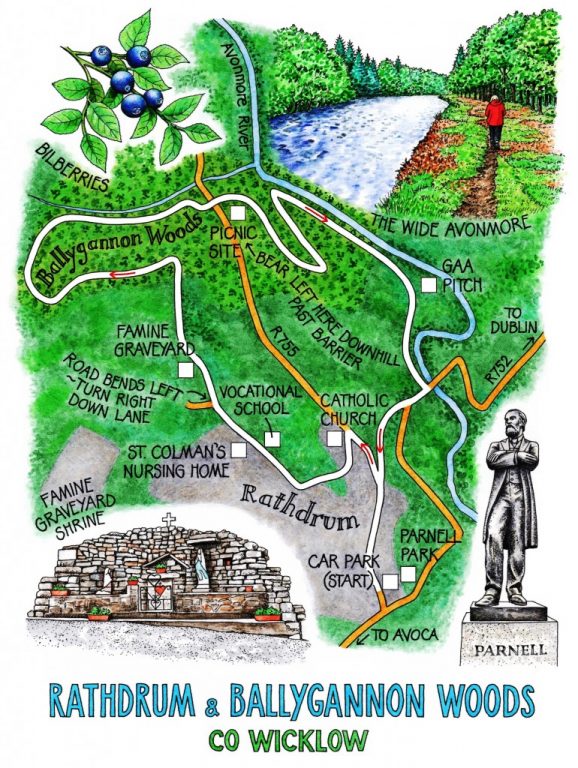Irish Independent – WALK OF THE WEEK – Christopher Somerville
13 August 2011
108. Rathdrum and Ballygannon Woods, Co. Wicklow

On a hazy grey afternoon with mist on the Wicklow hills, Charles Stewart Parnell stared out from his plinth in Rathdrum’s Parnell Park, a dewdrop on the end of his fine bronze nose. Nearby a gentleman of uncompromising aspect was selling ‘unsourced’ crockery from the back of a van. We wished him luck and set out through Rathdrum, an old-fashioned local shopping town where folk greet each other in the street with the easy familiarity of those who’ve known one another all their lives.
A bunch of youngsters were fooling around the lanes on a motorised scooter. “The famine graveyard? Down that lane and through the gate, mister.’
A walled shrine marks the spot. With nearby graveyards filled to overflowing, famine victims were put to rest by the thousand in this field. At other times, people too poor to afford a churchyard plot were buried here. This afternoon the sloping, hummocky field was full of the smell of pine trees and the murmur of softly rushing water. An old Mass path led us on, following horseshoe prints and boot marks in among the muted sounds and colours of Ballygannon Wood. Above dense thickets of holly climbed tall oaks, their crowns insubstantial and misty in the day’s low grey light. A rider, encountered at a crossing of tracks, loomed twice his size like a giant in a dream. There was something dream-like about the whole wood this afternoon, in fact, as though we had stepped through time’s wall into a parallel but not dissimilar world.
Plucking and savouring juicy little bilberries, we went on beside the trickle of a tributary stream, down through the lower section of Ballygannon Wood and over a muddle of cut trees lying like green-haired maidens in a swoon across the track. A noble idea is in process here. In response to late 20th-century fears that huge swathes of Ireland’s native woodlands were being recklessly felled, sixteen ‘People’s Millennium Forests’, including Ballygannon Wood, were bought to be restored and ‘dedicated for ever to the people of Ireland.’ A native broad-leaved tree has been planted for every household in Ireland. How very much we need these woods to survive today’s quick-buck imperatives.
Down in the depths of the wood we found the fast-rushing, slate-green torrent of the Avonmore River. There was a loud, chattery babble from the water-smoothed pebbles forming low islets midstream and along the undercut banks. Old gnarly oaks overhung the water. As we pushed our way through thickets of gorse and silver birch in already fading light, I wondered if this was the wide Avonmore in that lovely old song that goes to the tune of ‘For Ireland, I’ll Not Say Her Name’, which Cathy Jordan of Dervish sings so beautifully.
‘There’s a home by the wide Avonmore
That will sweep o’er the broad open sea,
And wide rivers their waves wash ashore
Whilst bulrushes wave to the breeze …’
It’s hard to come by facts about the poet who wrote this bittersweet love song, dense with yearning for a happy home and hearth.
‘Like a sick man that longs for the dawn,
I do long for the light of her smile …’
If conjectures ever can be facts, then the songsmith was a Kerry schoolmaster, one Finneen Scannell, around the turn of the 19th century. Finneen had reason to yearn – he hesitated too long to declare his love to his sweetheart, and returned home to find that his brother had married her instead. Bittersweet indeed. But that didn’t prevent me singing it to the splash and rumble of the river as we turned back home along the wide Avonmore.
WAY TO GO
MAP: OS of Ireland 1:50,000 Discovery 62; downloadable map/instructions (highly recommended) at www.discoverireland.ie/walking (Loop 119 – ‘Jubilee Loop’)
GPS: satmap.com
TRAVEL:
Rail (www.irishrail.ie) to Rathdrum
Bus (www.buseireann.ie) service 133 (Wicklow-Arklow)
Road: M/N11 to Rathnew; R752 to Rathdrum. Car park by Parnell Park.
WALK DIRECTIONS: Right out of car park; walk through the town to Catholic Church. Up steps at back of church; along path to road. Right for 500m; where road bends left to reach a junction, turn right down gravelled lane. In 150m left through gate (mirrored arrow/MA); bear right up field, through gate (MA) to Famine Graveyard. On through kissing gate, across field, though gate (MA) into wood. Follow MAs for 100m to fence with steps. Don’t cross; turn left (MA) by fence and follow path and MAs for 1.5 km through woods and down to cross R755. Through gateway and follow forestry road. In 100m at picnic site bear left past barrier and on downhill. At foot of slope, left (MA) along track to river. Right (MA) along riverbank. At GAA pitch follow lower edge; on along gravel lane to road. Fork right uphill into Rathdrum.
LENGTH: 4½ miles/6.5 km: allow 2 hours
GRADE: Easy
CONDITIONS: Path in Ballygannon Woods can be muddy/slippery
DON’T MISS … !
• famine graveyard
• bilberry berries in Ballygannon Woods (delicious)
• banks of the wide Avonmore
REFRESHMENTS: Bates Restaurant, Rathdrum (0404-29988; batesrestaurant.com)
ACCOMMODATION: Ballyknocken House, Glenealy (0404-44627; ballyknocken.com) – top-notch welcome, cooking and walking advice.
WALKING in IRELAND: Walking tour operators, local walks including Discover Ireland’s National Loop Walks, walking festivals throughout Ireland: www.discoverireland.ie/walking.
MUSIC: ‘For Ireland, I’ll Not Say Her Name (Ar Éirinn Ní Neosfainn)’ – on At The End Of The Day CD by Dervish (Kells Music)
BOOK: Christopher’s book Walking in Ireland (Ebury Press) contains 50 of his favourite Irish Independent walks.
INFORMATION:
Rathdrum Tourist Office: Market Square (0404-46262); www.visitwicklow.ie
csomerville@independent.ie